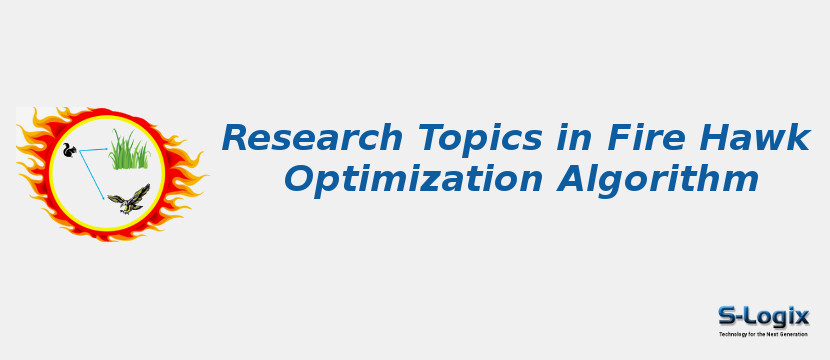Fire Hawk Optimization (FHO) is a recent variant of the Firefly Algorithm (FA) that aims to improve the convergence rate and the exploration ability of the original FA. FHO modifies the attractiveness function used in FA and introduces a new concept called "fire hawk" that represents the best firefly in the swarm.
The FHO as a new metaheuristic algorithm based on the foraging behavior of whistling kites, black kites and brown hawks birds. These birds are known as fire hawks because of their specific behavior to catch their prey naturally, especially due to setting (lightening) fire.
This algorithm is used to find the optimal solution for a given problem by simulating the interaction and movement of hawks in the search space. In the algorithm, the hawks represent the best solutions found in the firefly phase, and they move toward other fireflies to improve the quality of the solutions. The Hawks combine a local and global search to refine the solutions and find the optimal solution.
FHO is based on a swarm intelligence approach where a population of candidate solutions (hawks) searches for an optimal solution to an optimization problem by communicating and sharing information. Her how FHO works:
Initialization:FHO starts by generating an initial population of hawks, each representing a candidate solution to the optimization problem. The initial population is randomly generated within the feasible solution space.
Evaluation: Each hawks fitness is evaluated by applying the objective function of the optimization problem to its solution. The fitness value reflects how well the hawk solution satisfies the optimization problems constraints and objectives.
Movement: It moves towards better solutions by following three movement rules: attraction, repulsion, and mutation.
Attraction:Each hawk moves towards the best solution it has encountered (i.e., the global best solution).
Repulsion: Each hawk avoids getting too close to other hawks, which helps to maintain diversity in the population and avoid premature convergence.
Mutation:A small random perturbation is applied to each hawks position to introduce the stochasticity and explore new areas of the solution space.
Communication: The hawks communicate by adjusting their brightness based on their fitness value. Brighter hawks are considered more attractive and are more likely to attract other hawks toward them.
Termination:FHO terminates when a stopping criterion is met, such as a maximum number of iterations or a target fitness value.
Solution extraction: The final population of hawks represents a set of potential solutions to the optimization problem. The final population selects the best solution based on its fitness value.
Robustness: FHA algorithm is robust and can handle non-linear, non-convex, and multimodal functions with noise and uncertainties, making it suitable for real-world optimization problems.
Parallel processing: Easily parallelized to accelerate the optimization process, which makes it suitable for large-scale optimization problems.
Global optimization:This algorithm can find the global optimum solution rather than getting stuck in a local optimum.
Flexibility: It is easily adapted to different optimization problems by changing the objective function and parameters.
Complexity: FHO involves several parameters that must be carefully tuned to perform well. This can make it challenging to implement and may require extensive computational resources.
Limited scalability:FHO may not be well-suited for solving problems with many variables or complex constraints. It may struggle to maintain diversity in the swarm and get trapped in local optima.
Lack of theoretical foundation:FHO, like many metaheuristic algorithms, lacks a rigorous foundation. So its behavior and performance cannot be guaranteed or predicted with certainty.
Sensitivity to parameters: The performance of FHO is highly dependent on the selection of its parameters. If the parameters are not set correctly, the algorithm may converge to suboptimal solutions or fail to converge.
No guarantees on optimality: FHO, like other metaheuristic algorithms, cannot guarantee that the solution it finds is globally optimal. It is a heuristic method that aims to find a good solution within a reasonable amount of time, but it does not guarantee the quality of the solution.
Local optima:FHO, like other metaheuristic algorithms, may get trapped in local optima, suboptimal solutions that small perturbations cannot improve. It can limit the algorithms ability to find the global optimum, especially in complex optimization problems.
Convergence rate: FHOs convergence rate may be slow or converge prematurely, depending on the problems complexity and the algorithm parameter settings. Finding an optimal balance between exploration and exploitation is critical to achieving good convergence rates with FHO.
Sensitivity to parameters: The performance of FHO is sensitive to the choice of its parameters, including the attractiveness function, the mutation rate, and the initial population size. Tuning these parameters can be time-consuming and may require extensive experimentation.
Scalability: FHO may struggle to scale up to large-scale optimization problems with a large number of decision variables, constraints, or objectives. As the problem size increases, FHO may require more computational resources and become computationally infeasible.
Power system optimization: FHO has been used to optimize power systems by finding the optimal dispatch of generators and minimizing the systems operating cost.
Image processing: FHO has been used to optimize image processing tasks, such as image denoising, image segmentation, and feature extraction.
Financial portfolio optimization: FHO has been used to optimize financial portfolios by selecting the optimal mix of assets that maximizes the portfolio return while minimizing its risk.
Healthcare: FHO has been used to optimize healthcare systems by optimizing the scheduling of medical staff, allocating medical resources, and designing healthcare facilities.
Water resource management: FHO has been used to optimize water resource management by finding the optimal allocation of water resources for irrigation, hydropower generation, and other uses.
